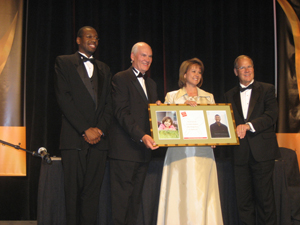Nancy Pelosi’s National Summit on Children
Last Tuesday I was asked to speak on Capitol Hill at House Speaker Nancy Pelosi’s National Summit on Children. I was honored to appear at the summit along with 20 other national experts and academics. The focus of the summit was on recent scientific findings and how they relate to early childhood education. The audience included 300 national leaders in research and services to children.

Donna Davidson with U.S. House Speaker Nancy Pelosi
I had the opportunity to share my experiences as a speech and language pathologist, an administrator of Easter Seals North Georgia and as the parent of a child with a disability.
I spoke of the importance of early intervention and treatment for children with disabilities. We need to improve the overall quality of services through the funding of research on best practices, as well as the development and implementation of a set of standards for early intervention practice. I cited the treatment of autism in young children as an example. We need research on best practices to support the effectiveness of these treatments so that both public programs and private insurance will cover these types of interventions.
I also spoke about the importance of strengthening linkages between Medicare Part C, Medicaid, private insurance, Temporary Assistance for Needy Families (TANF), and early care and education systems to ensure that decisions are being made in the best interest of children with disabilities.
The room was filled with energy and excitement and I left feeling hopeful. As Rep. Fattah of Pennsylvania stated in his closing remarks, the summit gives members a “baseline of knowledge that will help Congress come to grips with its responsibilities to children and families.”











